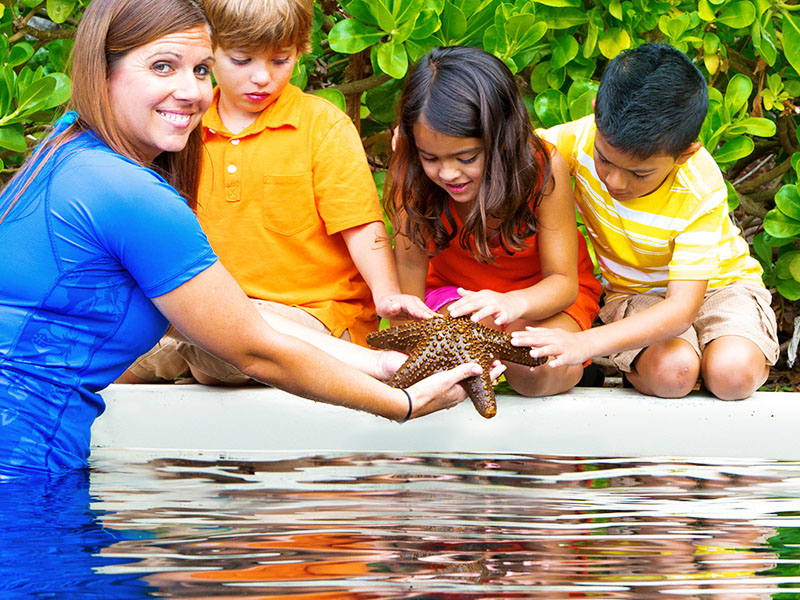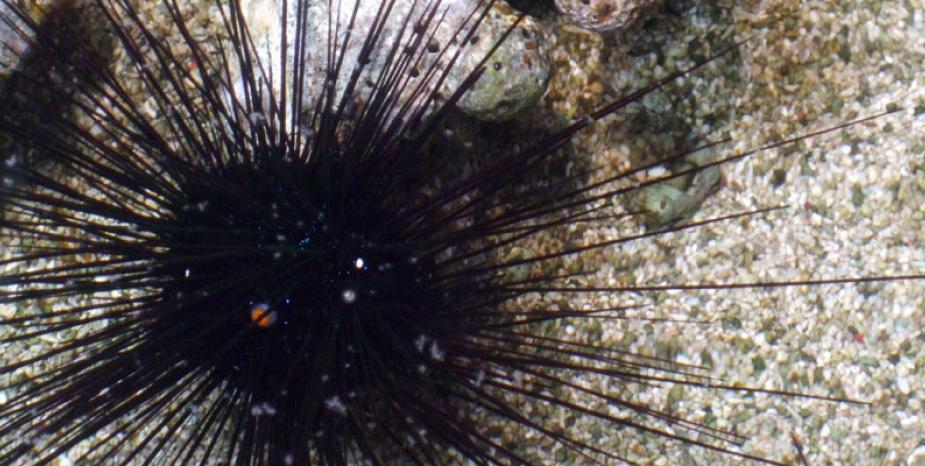Get your passes now! Offer ends 12/2 at 11:59PM HST.
Echinoderms are the group of animals that consists of sea stars, sea urchins, sea cucumbers, brittle stars and crinoids. They are part of the larger group of animals called INVERTEBRATES. We have a backbone and fish have a backbone, but sea stars and their cousins DO NOT have bones. Therefore they are referred to as invertebrates. Invertebrate means without a backbone.
Sea stars and their cousins belong to a group called Echinoderms. Echinoderm means spiny skin. If we break the word down echino = spiny and derm= skin, so these animals are spiny-skinned. Sea stars and their cousins are part of a group of spiny-skinned animals.
Sea Stars: Most sea stars have five arms. The underside of each arm holds 2-4 rows of tube feet, or suction cup feet. They use these feet to hold onto and move around on rocks and on the ocean floor.
Brittle stars: Brittle means it’s fragile and breaks easily. The Brittle stars have spiny arms which enable the star to anchor inside holes or crevices. They are very sensitive to light, and are mostly found under rocks and in crevices.
Sea urchins: Their jaws and teeth allow some species to bore directly into rocks. All sea urchins have a hard skeleton made out of calcium, called a test, under their spines. Biologists are able to identify the kind of urchin just by looking at its test.
Sea cucumbers: Sea cucumbers have a mouth on one end of its body. They may look like a worm but they hold a lot of water in their body. When we touch it, it feels soft instead of poky, but it has tiny little spines along its body. Sea cucumbers are like vacuums of the ocean. They suck in the sand, take what nutrients they want, and the sand comes out the other end. They are filter feeders using their tentacles to gather food and bring it into the mouth.


Pentamerous Radial Symmetry: They all have pentamerous radial symmetry. Wow, those are big words. Let’s say it together. Pentamerous Radial Symmetry. Very good.
Tube Feet: They all have tube feet
Regenerate: They can all regenerate body parts and tissues.
Spiny Skin: They all have spiny skin
Pentamerous Radial Symmetry
One characteristic of an echinoderm is that they all have pentamerous radial symmetry. This simply means they all have 5 equal body parts. You can divide these animals into five equal parts, and every part is the same. For example, most sea stars have five arms or a multiple of five arms. The sea cucumber, although you may not be able to see it by just looking at it, does have this five part symmetry. If you were to peel it open like a banana, you would see five equal sections. A sea urchin looks round however, if all the spines fell off, its skeleton, or test, would show it has 5 body parts. The sea urchin has five parts just like the brittle star and the sea star.
Tube Feet
When we go for a walk we use our feet. Echinoderms have feet too, but they are called tube feet. They have many little tube feet that are like little hoses with suction cups at the end. A feature that is unique to this group is their water vascular system. They have water filled canals that end in the tube feet, enabling this group to anchor themselves to substrate such as rocks and corals. They use their tube feet to attach to rocks, but also for locomotion. All echinoderms have tube feet. Like we mentioned in the introduction, tube feet help the animal to move and hold onto the rocks.
Regeneration
Another characteristic of echinoderms is that they are capable of regeneration. Regeneration means that echinoderms are able to “re-grow” or restore organs, tissues or body parts that are injured or lost. Sea stars for example are able to re-grow a missing arm. The brittle star is a champion when it comes to growing a new arm. Brittle stars like to hide under rocks. They may not realize that one of their arms is sticking out and waving in the ocean. Sometimes, hungry fish come along and grab one of the brittle star’s arms. The brittle star lets the arm break off out of fear for its life, which allows the brittle star to get away from the predator. Even though these animals can re-grow an arm you never want to pull off the arms of these animals. It takes a long time for them to grow back!
Spiny Skin
Echinoderm means spiny skin so the last characteristic they all share is….spiny skin. The spines are very obvious in some echinoderms. The sea urchins, for example, have obvious spines covering their body. But for others, like the sea cucumbers, it’s less obvious. Sea cucumbers do, however, have tiny little spines called spicules in the walls of their body that we aren’t able to feel as we touch them.
All echinoderms have mouths. They have to eat just like you and I. Their very tiny mouth is located on the underside of the animal. Usually sea stars eat small pieces of food they find on the ocean bottom. However, their favorite foods are oysters and clams. The mouth of the sea star is on the underside of the body where the base of all the arms meet. The opening is very small, maybe a quarter of an inch wide on a full grown adult. With a mouth so small it seems hard to believe that they could eat anything of very large. There are no mouthparts or claws that could be used to tear flesh into bite-sized chunks. You would look at this animal and think even if it managed to capture its prey, there is simply no way it could get the food into the stomach. Which is true, so rather than bring the food to the stomach, the sea star brings its stomach to the food. Once the prey is captured the jelly-like stomach actually oozes out of the tiny mouth in a process known as eversion. When the everted stomach is outside of the sea star’s body it is literally turned inside out, exposing the digestive enzymes to the prey and partially digesting the meal outside of the body. The liquefied food is then absorbed through the stomach lining and into the body and is transferred to organs in the arms, where the digestive process is completed. When it’s all done feeding, the stomach muscles contract, pulling it back inside the body again. Anything inedible, such as shell fragments or spines are ejected back out of the mouth by muscle contractions. What an amazing adaptation!